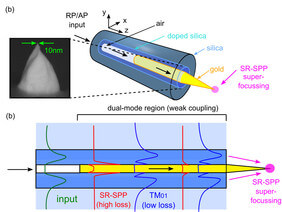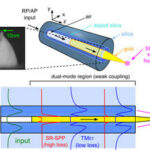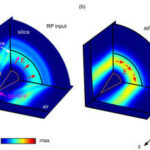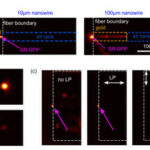- Home
- Research
- Fiber Photonics
- Research results
- Excitation of Short-Range Surface-Plasmon Polaritons in a Gold Nanowire-Enhanced Step-Index Fiber
Excitation of Short-Range Surface-Plasmon Polaritons in a Gold Nanowire-Enhanced Step-Index Fiber

23.04.2018
We have demonstrated a nanowire-enhanced step-index fiber for guiding light to plasmonic tips via a novel coupling scheme. We excited short-range plasmons via low-loss hybrid modes that are propagated in the nanowire section and focused at the tip’s apex. The wire length can be orders of magnitude longer than the attenuation length of short-range plasmons, significantly reducing demands on production.
By: Alessandro Tuniz // Stefan Weidlich // Markus A. Schmidt
Surface plasmon polaritons (SPPs) enable device miniaturization via sub-wavelength field confinements and order-of-magnitude intensity enhancement (e.g., with sharp metal nanotips (the apex of which is ~10 nm) for scanning optical near-field microscopy). Although it is convenient to integrate tips on optical fibers, few reports have been made in this respect to date: phase-matching, mode-matching, and sub-wavelength waveguide alignment make background-free transmission to fiber nanotips challenging.
In [1] we introduced and experimentally demonstrated a fiber-based nanoprobe for the efficient end-fire excitation of short-range (SR) SPPs on a metallic nanotip. The monolithic device (see Fig. 1a) is composed of three sections. The first is a cylindrical silica step-index fiber with a GeO2-doped core (radius: 2 μm; doping level: 9 wt.%) and a central nanobore of 550 nm. The second section contains a gold nanowire (NW) in the center of the step-index fiber. The third section is the actual gold nanotip, which has an apex of ~10 nm (see inset of Fig. 1a).
The production of the elements starts with the pressure-assisted melt-filling of a nanobore fiber. For this purpose, we identified the beginning of the NW inside the fiber and used focused ion beam milling to produce a cut on the outer cladding. By cleaving at this location, we obtained an integrated gold NW at a length of 10-100 µm inside the fiber core. A gold nanotip of sub-wavelength dimensions protruding from the fiber was formed naturally.
The schematic in Fig. 1b illustrates how the device operates. The radially-polarized (RP) input (green) excites two RP modes in the gold-filled section: the dielectric TM01 mode (energy mostly in the dielectric (blue)) and the plasmonic SR-SPP (energy mostly near the gold surface (red)). Since the SR-SPP mode decays after a few µm, only the 01 mode “survives” and excites the SR plasmonic mode at the fiber end face via its tails in the metal, which then focuses on the tip. The hybrid nature of the dielectric mode relaxes the production constraints, allowing functional devices with nanowire lengths up to hundreds of micrometers. For cylindrically-polarized input, finite element calculations (see Fig. 2) show that a donut-shaped mode is always transmitted but that only an RP mode induces an accumulation of energy at the apex of the nanotip (see Fig. 2a), whereas azimuthally-polarized (AP) input does not induce an accumulation of energy at the tip.
The experimental characterization relies on launching broadband (500-750 nm) light (either AP or RP) into the empty part of the device. The side-scattered (perpendicular to fiber axis) light is imaged onto a CCD camera, with the opportunity of inserting linear polarizers (LPs) and a color filter (λ=650 nm). For RP input, the side-scattered light shows a bright spot at the fiber end face, which is unaffected by the length of the nanowire (see Fig. 3a) – provided that gaps do not occur along the nanowire [2] – in support of the hybrid mode-assisted excitation scheme. Additionally, the fiber scatters the most when the input is radially polarized (see Fig. 3b) and the least when it is azimuthally polarized (AP), as would be expected. Finally, it was shown that the light at the apex is axially polarized (see Fig. 3c), as expected for SPP focusing. This indicates that the scattered light originates from SPP mode and reaches nanotips with apex dimensions below 10 nm.
In summary, we have experimentally implemented a monolithic broadband fiber-based nanoprobe for sub-wavelength near-field confinement at the apex of the nanotip, which operates by mode coupling between an RP dielectric-like mode and an SR-SPP on a gold nanowire, transmitting sub-wavelength radiation to and from the apex of the nanotip. In collection mode, light can also be coupled from the plasmonic mode into the dielectric core. This device will find applications in near-field microscopy and nanophotonics and can potentially offer a significantly improved resolution compared to current SNOM tips.
Funded by: Humboldt Foundation



